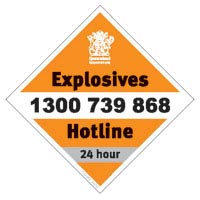Reporting explosives incidents
The majority of the provisions of the Resources Safety and Health Legislation Amendment Act 2024 commenced on 1 September 2024. Updated guidance material is being developed and will be published in the coming weeks.
The incident notification process will change, however, please continue notifying incidents through your current process for now. RSHQ will send through further information when it is available.
Visit our website for more information.
In an emergency call 000.
After any immediate threat has passed, you must notify Resources Safety and Health Queensland (RSHQ) when an explosives incident occurs.
Under the Explosives Act 1999, the Chief Inspector of Explosives must be notified of explosives incidents as soon as possible via the approved incident notification form. Currently, you can also notify by calling the Explosives Emergency Hotline (1300 739 868).
These notifications are essential to allow us to respond appropriately, for example by sending an inspector to the site or securing a scene to ensure all evidence is maintained for investigations.

What needs to be notified
The Explosives Inspectorate must be notified if one of the following events occurs in relation to an explosive:
- actual or apparent loss or theft of explosives
- attempted theft or security threat
- accidental explosion, fire or spillage
- death of or an injury to a person
- unexpected damage to property
- an event, including a misfire that has the potential to cause any of the above.
Examples of explosives incidents that need to be notified are:
- explosives stolen or missing from a magazine
- explosives inventory/daily use records that don't agree with stock on hand
- ANE spill involving a transport vehicle
- misfires from the firing of a shot or found during excavation
- fume event that breaches the exclusion zone, or causes an unplanned evacuation of people
- flyrock that goes beyond the nominated exclusion zone
- people breaching explosives exclusion zones.
Call the Explosives Inspectorate on 1300 739 868 for advice if you have any doubts about whether an event needs to be reported.
Who is responsible for the notification
The notification must be made by either:
- the authority holder whose explosives are involved in the incident
- or
- the relevant person who was in custody or control of the explosives at the time of the incident.
How to notify the Explosives Inspectorate
Explosives incidents on mining leases
RSHQ is transitioning to an online incident reporting system, which will drive change in accordance with the recommendations from the Brady Review into deaths in mining.
Explosives incidents on mine sites will be the first to transition to this new reporting system. When your mine site has transitioned to this new system, you will not need to submit a separate report to the Explosives Inspectorate.
This online reporting system will be RSHQ's approved form, which collects information that will be used to proactively share knowledge and industry data analytics.
Authority holders will be advised before they are transitioned to this system.
Explosives incidents other than mine sites
For activities and authority holders that are not operating on a mine site or have transitioned to the new reporting system, you must complete and submit the approved incident notification form as soon as possible after the incident.
Ensure you have the following information available before completing the incident notification form:
- address or GPS coordinates of the incident location
- date and time of the incident
- description of the incident, including person's actions, equipment involved, the activity being undertaken and any other relevant factors
- name of explosive involved and as much information about the explosive as possible (e.g. quantity involved, UN number, class/division, batch number, manufacturer, date of manufacture)
- information regarding emergency services and other agencies involved, evacuations, security, media presence, witnesses and any vehicles involved if known
- any photos or documents relevant to the incident to attach and upload.
Other reporting requirements
In addition to the Explosives Inspectorate, you may also need to separately notify other divisions of RSHQ, if your mine site has not transitioned to the new online reporting system. Other divisions of RSHQ include:
- Coal Mines Inspectorate, if the incident occurred at a coal mine
- Mineral Mines and Quarries Inspectorate, if the incident occurred at a mineral mines or quarry
- Petroleum and Gas Inspectorate, if the incident occurred at operating plant or relates to gas devices.
Separate notifications may also be required to the Queensland Police Service, Workplace Health and Safety Queensland, and other government departments or agencies.
Requirements of safety and security management systems
Your safety and security management system (SSMS) must include systems and clear procedures for reporting and investigating incidents, including:
- the process to complete and submit an explosives incident notification or the online incident reporting system
- incident investigation methodologies
- verifications that controls to prevent incident re-occurrence are implemented and effective.
You should also keep a record of:
- all incidents that have occurred
- incident investigations for all incidents that have occurred
- evidence that investigation recommendations or new/additional/modified controls are implemented into the safety and security management system
- events that trigger legislative review of security and safety plans.